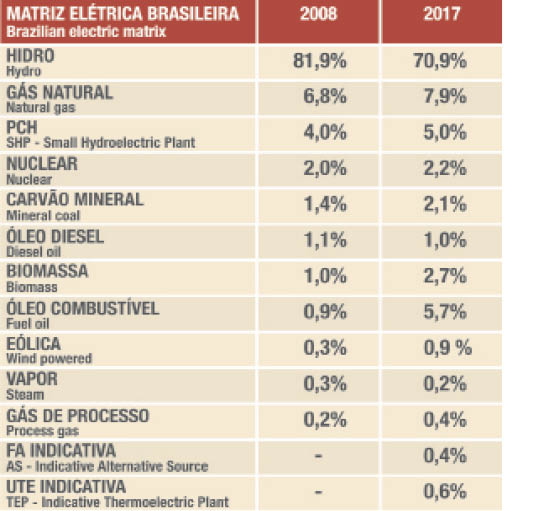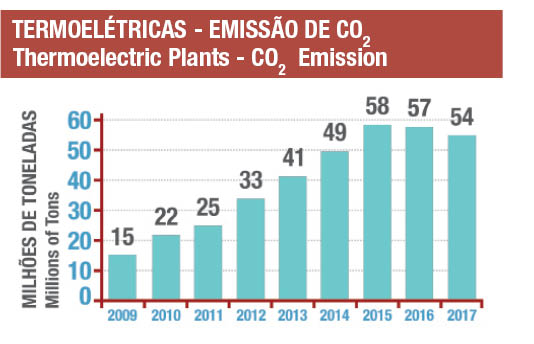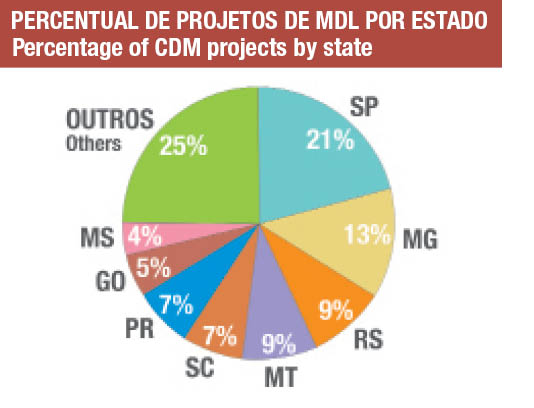Carlos Roberto Silvestrin e Leonardo Caio Filho
Vice President and Expert Engineer in Bioelectricity
Op-AA-21
Ethanol and bioelectricity reducing the intensity of CO2
The intensity of CO2 emissions has been increasing considerably in recent years, due to the expansion of thermoelectric generation, mainly from fuel oil, diesel and mineral coal, together with the expansion of the industrial park. Unless effective measures to control CO2 emissions are taken, the temperature on the planet may increase by 7 °C in the next 100 years, according to predictions that have been the object of studies by a number of renowned research entities, which may result in important consequences for the planet, such as the melting of polar caps and the destruction of several food species.
 With this scenario, the expansion in the bioenergy supply offer will be essential to offset the intensity of CO2 emitted to the atmosphere. In this regard, we may emphasize bioelectricity (cogeneration of electric power from sugarcane biomass) and the production of ethanol as essential elements in diminishing GHG emission intensity. Both ethanol and bioelectricity are beginning to be perceived as important “CO2 reducers”. In the period 2005 to 2008, in the New Energy from Alternative Sources and Reserves Auctions, on average 14,963 MW of energy were traded, divided among hydro (23.3%), thermal (fuel oil, diesel oil, mineral coal and natural gas) with 68.4%, and bioelectricity (8.4%).
With this scenario, the expansion in the bioenergy supply offer will be essential to offset the intensity of CO2 emitted to the atmosphere. In this regard, we may emphasize bioelectricity (cogeneration of electric power from sugarcane biomass) and the production of ethanol as essential elements in diminishing GHG emission intensity. Both ethanol and bioelectricity are beginning to be perceived as important “CO2 reducers”. In the period 2005 to 2008, in the New Energy from Alternative Sources and Reserves Auctions, on average 14,963 MW of energy were traded, divided among hydro (23.3%), thermal (fuel oil, diesel oil, mineral coal and natural gas) with 68.4%, and bioelectricity (8.4%).
One should note that the energy traded in this period was predominantly sourced from conventional thermal plants. As a result of these auctions, the national electric matrix, that in May 2008 comprised 87% of renewable sources, will decrease to 80% of renewable sources in December of 2017.
The graph shown, drawn up by energy research company EPE – Empresa de Pesquisa Energética, illustrates the transition in the electric matrix during the referenced period. Apart from the fact that these thermal plants emit greenhouse gases (GHG) at a high rate, they are also centrally located, which may cause greater impact in the case of problems in a thermal plant: higher investment, higher transmission cost and difficulties in licensing.
Cogeneration, on the other hand, is distributed energy: if a cogeneration center is delayed, it will not cause any major impact on the system, the investments are smaller, and it is easier to connect to the power system and to obtain environmental licensing.
 As a consequence of the increase in thermoelectric plants using diesel oil and fuel oil to operate, the greenhouse gas emission quantity will increase from 15 million tons per year in 2009 to 58 million in the next 5 years, according to projections by PSR Consultoria.
As a consequence of the increase in thermoelectric plants using diesel oil and fuel oil to operate, the greenhouse gas emission quantity will increase from 15 million tons per year in 2009 to 58 million in the next 5 years, according to projections by PSR Consultoria.
The expansion in the supply offer of bioelectricity, which represented 1,848 MW of installed capacity in April of 2004, nowadays is represented by 3,650 MW and will further increase by 839 MW in 2009 and another 2,472 MW in 2010, relative to projects that trade energy in the Energy Auctions in the Regulated Contracting Environment (RCE).
COGEN created a databank management office, DataCogen, with detailed information on all projects in operation in Brazil, in which the kinds of equipment used in each center, and data on energy trading, can be viewed, as well as online reports generated.
COGEN/UNICA undertook a scenario analysis of bioelectricity expansion, considering theoretical power using bagasse and straw, and also of another scenario using market data. In the former, one can achieve a capacity of 29,411 MW installed by 2018, and, in terms of market potential, this figure may reach 22,315 MW. The premises for attaining these scenarios are set forth in the shown table: With the feasibility of these bioelectricity projects, energy representing 15% of the national electric matrix will be added to the electric system, which can be analyzed as a replacement of the traditional thermoelectric plants that use fuel oil as the primary energy source; in this manner one will reduce the intensity of the CO2 that would otherwise have been launched by thermoelectric plants using fuel oil, diesel and mineral coal.
 With respect to the carbon credit market, Brazil represents 8% of total CDM project activities in the world. In this context, renewable energy amounts to 50% of CDM projects in Brazil.
With respect to the carbon credit market, Brazil represents 8% of total CDM project activities in the world. In this context, renewable energy amounts to 50% of CDM projects in Brazil.
Regarding bioelectricity in new greenfield projects, the methodology for carbon credit generation using sugarcane biomass for cogeneration of electricity is ACM006 - Consolidated Methodology for Electricity Generation from Biomass Residues, and the potential for carbon credit generation equals approximately 1,680 tons of CO2 per year for each 1 MW of installed capacity, and since the estimated capacity for the 2018/19 harvest is on average 14,411 MW, one would have 30 million tons of CO2 per year.
It is important to emphasize the processing of vinasse using CH4, in which the ACM0014 – Mitigation of GHG Emissions from Treatment of Industrial Wastewater methodology is employed, in which this technology is applied in anaerobic treatment biodigestors and electromechanical equipment (generation of bioelectricity).
For each 13 billion liters of ethanol produced, a vinasse volume of 13 million m³ is produced, representing a potential of 4.2 million tons of CO2 per year. There is also an ethanol utilization project to replace diesel in bus fleets, using the methodology MAS III.S - Introduction of Low Emission Vehicles to Commercial Vehicle Fleets, which has a potential of 15,000 tons of CO2 per year. Other projects with CO2 generation potential one can highlight are: the one that eliminates incineration of harvested straw, reforestation using biomass for cogeneration of electricity and the retrofitting of existing mills, replacing low pressure boilers with high pressure ones.
Of 1,120 CDM registered projects in the world. Brazil ranks third, with 14%, only behind India (31%) and China (21%). In Brazil, the State of São Paulo has 21% of all projects. Already government approved electric power projects that meet the CDM requirements total 3,453 MW (32% from hydroelectric plants; 32% from cogeneration with sugarcane bagasse, and 19% from small hydroelectric plants).
Considering the entire biomass potential available in Brazil, particularly sugarcane biomass, we will have the unique opportunity to strengthen the presence of bioenergy in the energy matrix, which will continue to be clean and renewable, under distinct conditions in comparison with all other countries, capable of accessing carbon credit revenues to the extent Brazil offers the most desirable “CO2 reducers” in the world.





